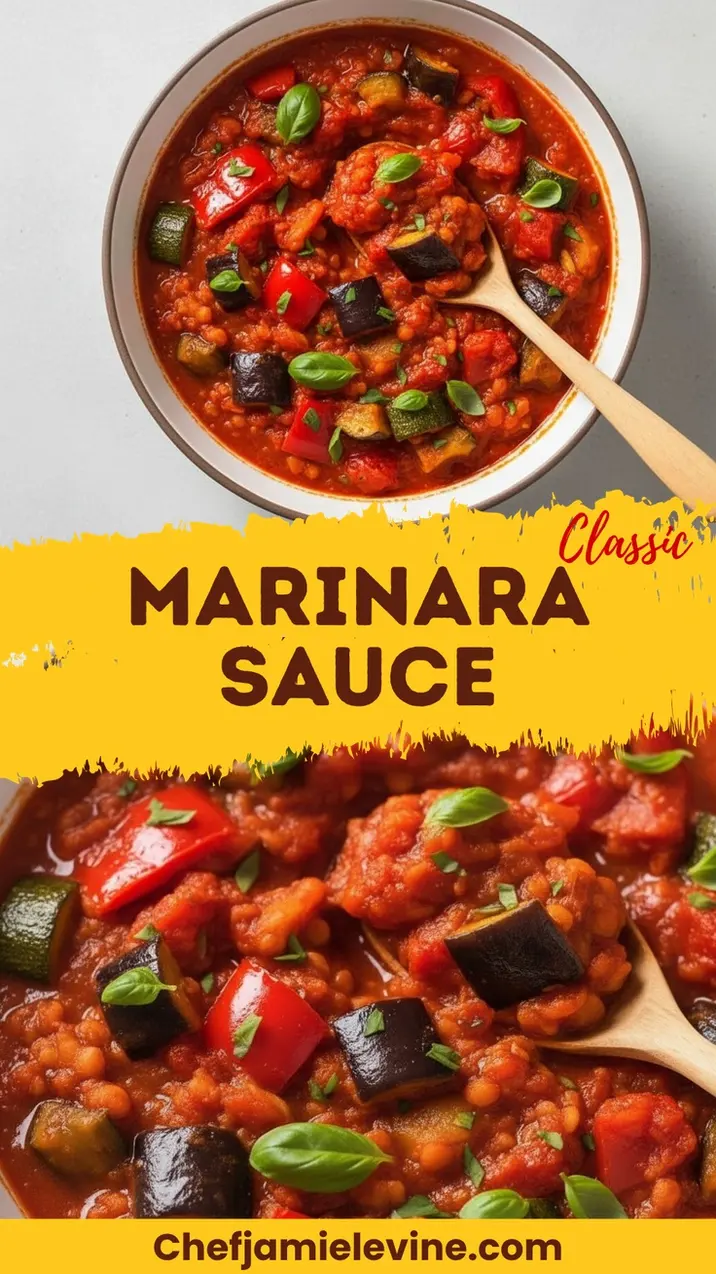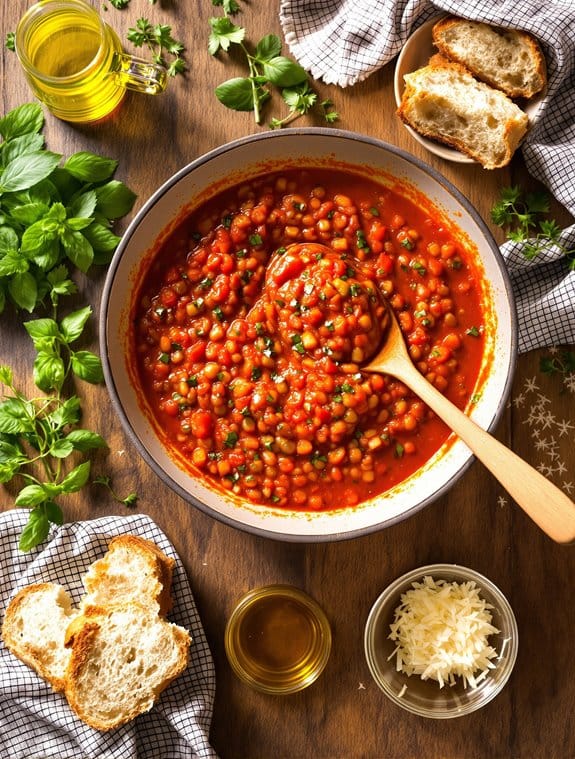Why You’ll Love this Garden-Fresh Marinara Sauce
Why would anyone spend hours making marinara sauce from scratch when the grocery store shelves are lined with jars? Because, my friends, the difference is transformative.
I’ve never tasted anything like the sweet-savory complexity that comes from roasting those tomatoes and peppers. The secret? Your garden’s bounty, transformed.
This sauce lets every vegetable shine—carrots add sweetness, broccoli brings nutrition, and those roasted tomatoes develop a depth no jar can match.
Plus, you control every ingredient. No mysterious additives or excessive salt, just pure vegetable goodness.
And that moment when it’s simmering? Your kitchen will smell like an Italian grandmother moved in.
What Ingredients are in Garden-Fresh Marinara Sauce?
This garden-fresh marinara sauce celebrates the natural flavors of summer vegetables, transformed through roasting and simmering into something truly magical. Unlike store-bought versions that often contain preservatives and excessive sodium, this homemade sauce lets you control every element while showcasing the pure essence of each vegetable. The roasting process caramelizes the tomatoes and peppers, adding a depth that simply can’t be bottled.
Ingredients:
- 12 tomatoes, halved and seeded
- 4 bell peppers (any color you prefer)
- 1 head broccoli, cut into florets
- 1 large onion
- 4 cloves garlic
- 4 carrots
- Salt and pepper to taste
- Fresh parsley
- Fresh basil
- Fresh oregano
- Optional: small amount of sugar (to balance acidity if needed)
When selecting your vegetables, freshness truly matters here. Garden-grown tomatoes will yield dramatically better results than pale, winter grocery store varieties. Don’t worry about perfect measurements for the herbs—this recipe invites creativity and personal preference. The beauty of making sauce from scratch is adapting it to your taste. If you find yourself with an abundance of garden vegetables beyond what’s listed, consider adding a handful of spinach or some zucchini. They’ll disappear into the sauce while boosting its nutritional profile without changing the classic marinara character.
How to Make this Garden-Fresh Marinara Sauce

Creating this vibrant marinara sauce begins with roasting, which develops those deep, caramelized flavors that make homemade sauce so special. Start by cutting 12 tomatoes in half and removing the seeds, then prepare 4 bell peppers for roasting. Place these vegetables on a baking sheet and roast until their skins begin to blister and blacken slightly.
The magic happens during this step—the natural sugars concentrate, and that slightly smoky flavor emerges. Once roasted, steam the peppers briefly and peel away their skins, which can be a bit fiddly but so worth the effort.
Next comes the fun part: transformation time. Take your roasted tomatoes and peppers, along with 1 head of broccoli (cut into florets), 1 large onion, 4 cloves of garlic, and 4 carrots, and add them to your food processor. Give everything a good whirl until you reach a “smoothish” consistency—not completely pureed, mind you, but no massive chunks either.
Who doesn’t love that perfect in-between texture that gives your sauce character? Transfer this vegetable mixture to a large pot, bring it to a boil, then immediately reduce the heat to maintain a gentle simmer.
As your sauce simmers away, chopping fresh herbs becomes your next task. The recipe beautifully leaves the herb quantities up to you—some days I’m in a basil mood, other days oregano calls my name. Add your chosen amounts of parsley, basil, and oregano, along with salt and pepper to taste.
Let the sauce continue simmering until it reaches your preferred thickness, then add the herbs and seasoning for the final 10 minutes of cooking. If you find the sauce tastes slightly acidic (though the roasting usually prevents this), a small pinch of sugar works wonders to balance the flavors.
The finished sauce works perfectly with pasta or as the base for homemade pizza—or honestly, I sometimes just dip bread right into the pot when nobody’s looking.
Garden-Fresh Marinara Sauce Substitutions and Variations
Looking for ways to adapt this marinara sauce to suit your pantry or preferences?
I’ve tried countless variations over the years with delicious results.
Swap bell peppers for roasted red peppers from a jar when you’re short on time.
No broccoli? Try zucchini, spinach, or even mushrooms for a different flavor profile.
The herbs are completely customizable—rosemary and thyme create an earthier sauce, while red pepper flakes add welcome heat.
For a creamier version, I sometimes stir in a splash of heavy cream or coconut milk just before serving.
And when tomatoes aren’t in season, good-quality canned San Marzanos work surprisingly well.
What to Serve with Garden-Fresh Marinara Sauce
What dishes truly shine when paired with this garden-fresh marinara sauce? I’m practically obsessed with how versatile this sauce is.
Toss it with al dente pasta—spaghetti, penne, or rigatoni—for a simple weeknight dinner. It’s divine spooned over crispy chicken parmesan or used as a dipping sauce for crusty garlic bread.
I love to ladle it onto homemade pizza dough, topped with fresh mozzarella and basil.
Sometimes, I’ll even use it as a poaching liquid for eggs, creating a rustic shakshuka. The roasted veggie flavors make an ordinary dish extraordinary, transforming even plain polenta into something I can’t stop eating.
Final Thoughts
After discovering this garden-fresh marinara sauce, I’ll never go back to store-bought versions again. There’s something magical about transforming garden vegetables into a rich, vibrant sauce that elevates any pasta dish or pizza.
What I love most is how customizable it is. Add more garlic if you’re a garlic fiend like me, or toss in extra basil for that aromatic punch. The roasting step really does eliminate acidity, though a pinch of sugar works wonders in a pinch.
Next time you’ve got a vegetable surplus, give this recipe a try. Your taste buds, and anyone lucky enough to share your table, will thank you.

Marinara Sauce With Roasted Vegetables
Ingredients
Equipment
Method
- Preheat your oven for roasting the vegetables.
- Cut the tomatoes in half and remove the seeds. Prepare the bell peppers for roasting.
- Place the tomatoes and bell peppers on a baking sheet and roast until their skins begin to blister and blacken slightly.
- Once roasted, steam the peppers briefly, then peel away their skins.
- In a food processor, combine the roasted tomatoes, peeled peppers, broccoli florets, onion, garlic, and carrots.
- Pulse until you reach a semi-smooth consistency – not completely pureed but without large chunks.
- Transfer the vegetable mixture to a large pot and bring to a boil.
- Reduce the heat immediately to maintain a gentle simmer.
- While the sauce simmers, chop your fresh herbs – parsley, basil, and oregano.
- Continue simmering the sauce until it reaches your preferred thickness.
- Add the fresh herbs, salt, and pepper during the final 10 minutes of cooking.
- If the sauce tastes acidic, add a small pinch of sugar to balance the flavors.



